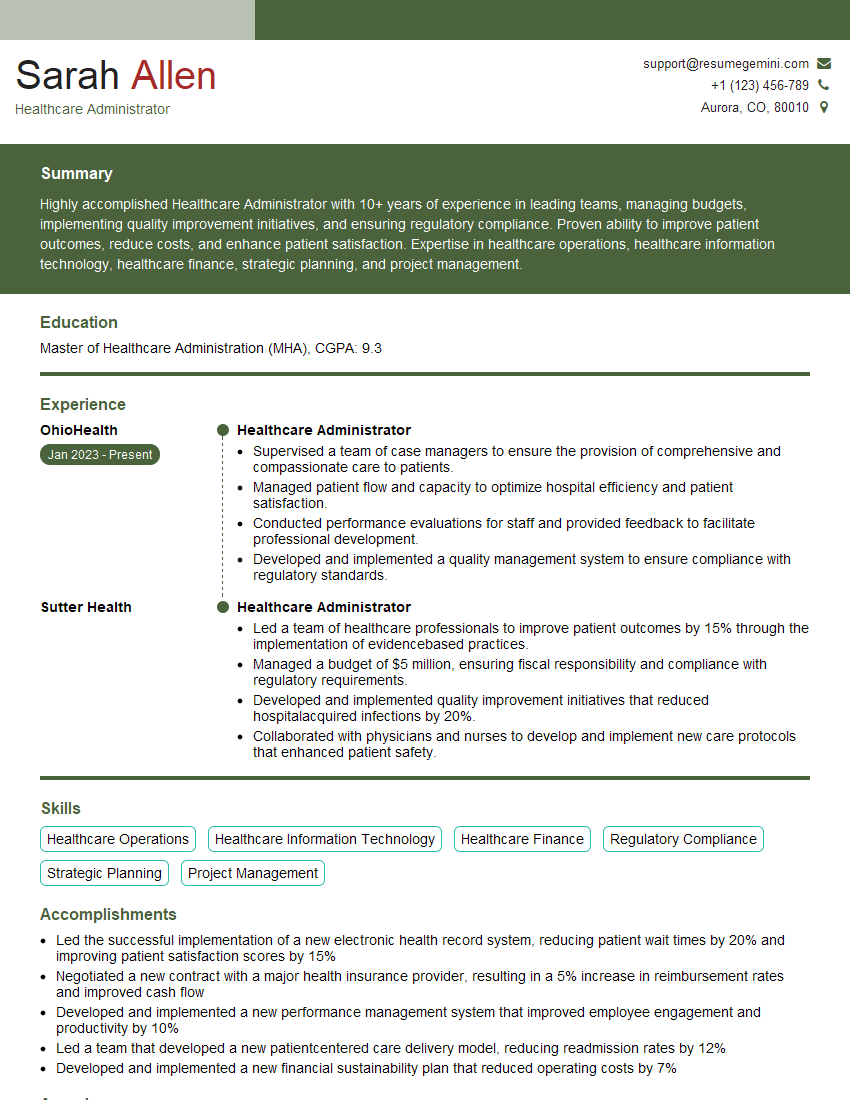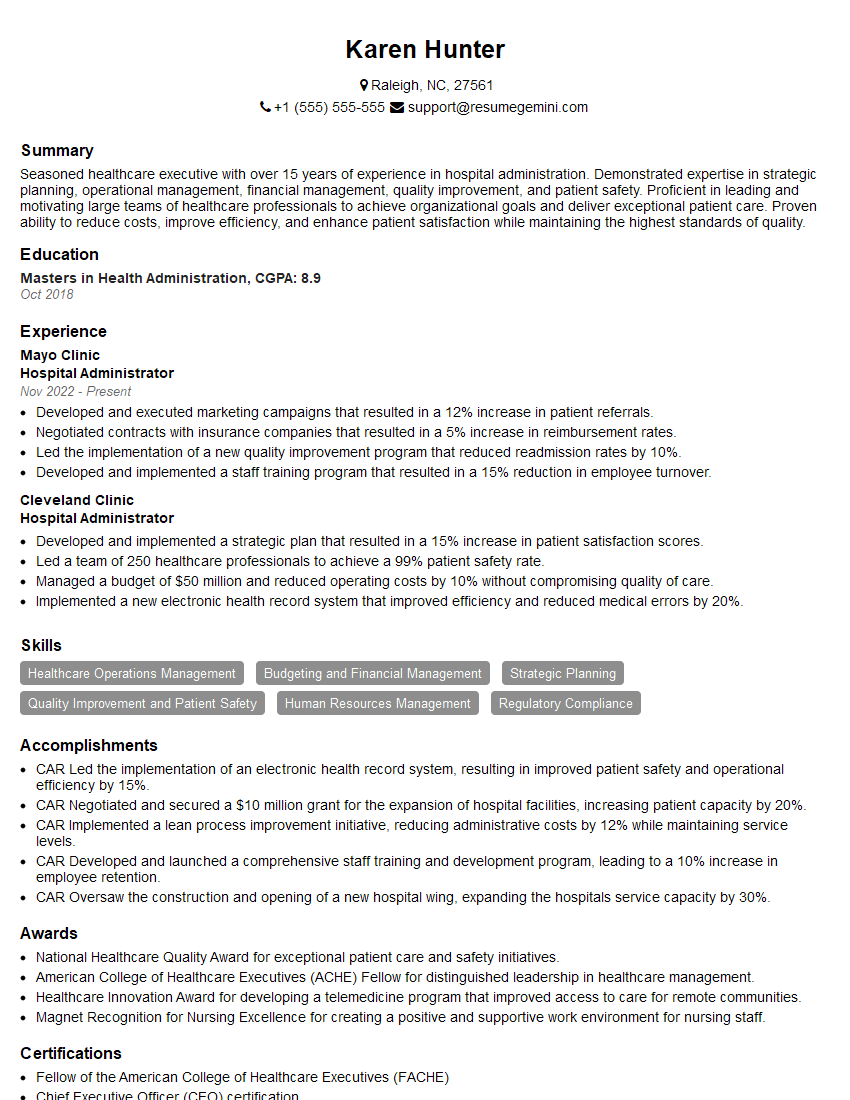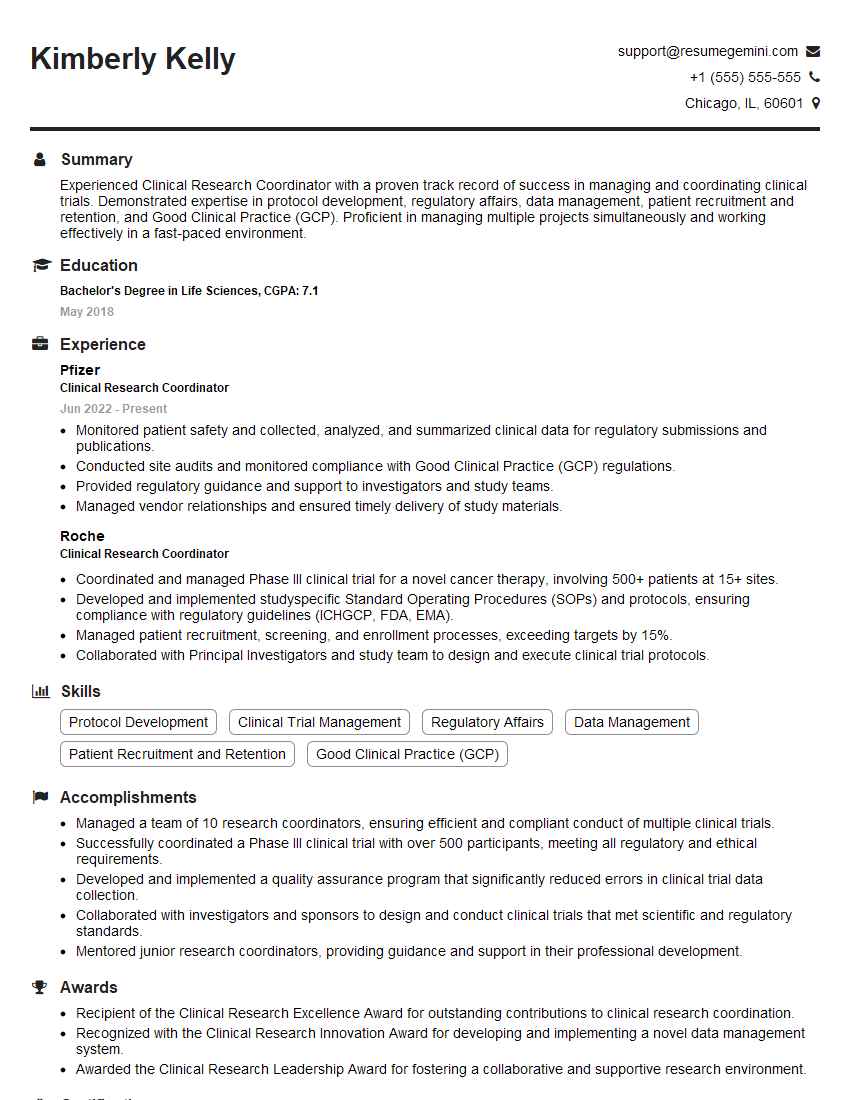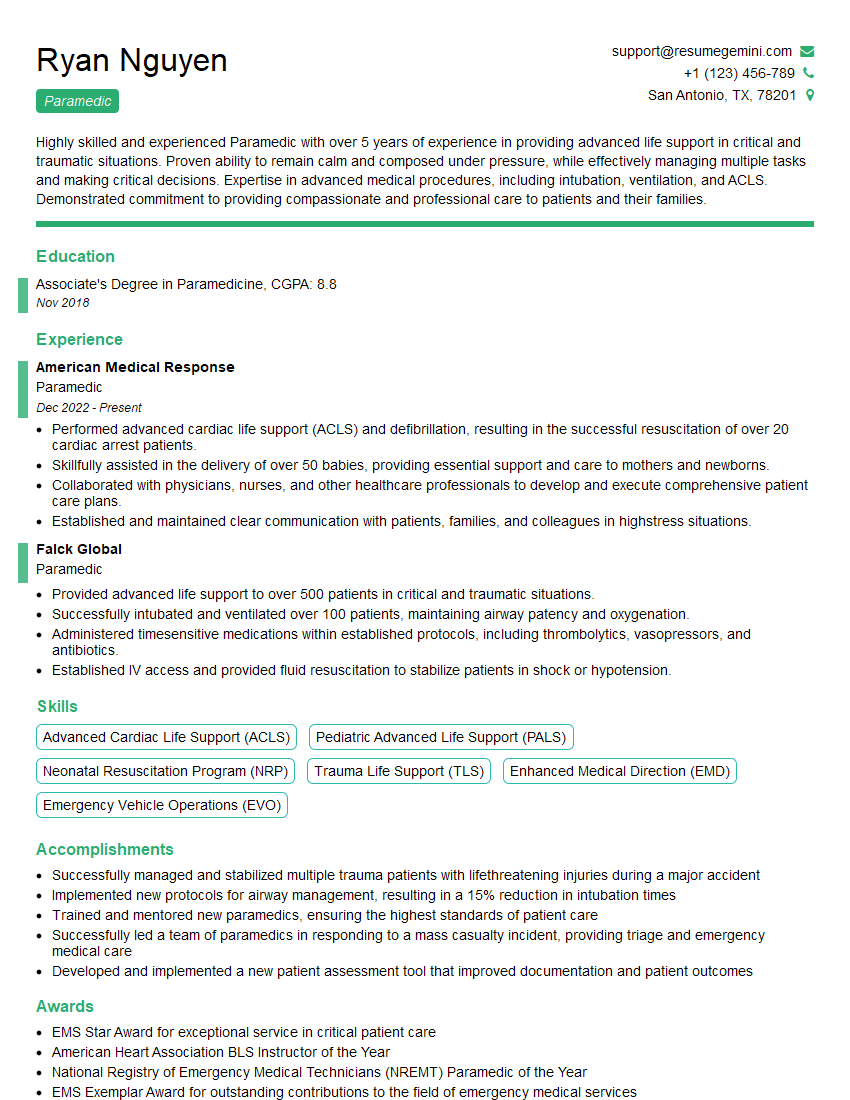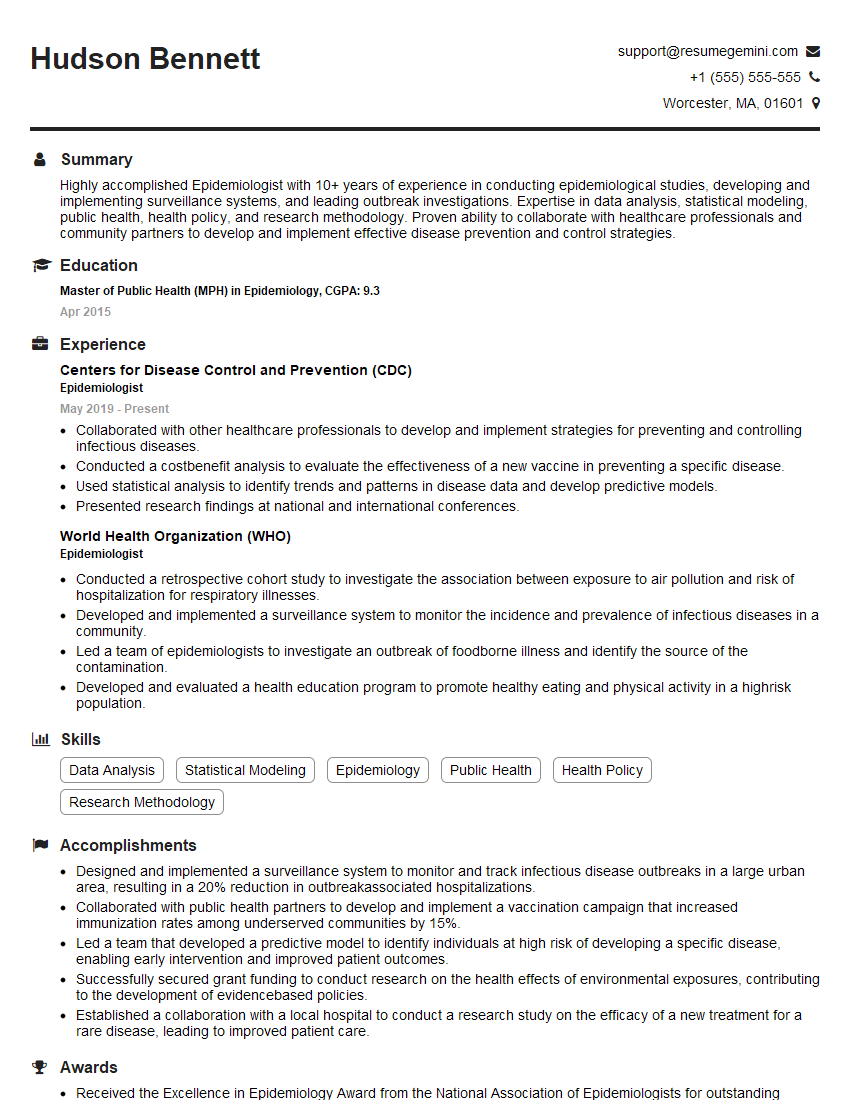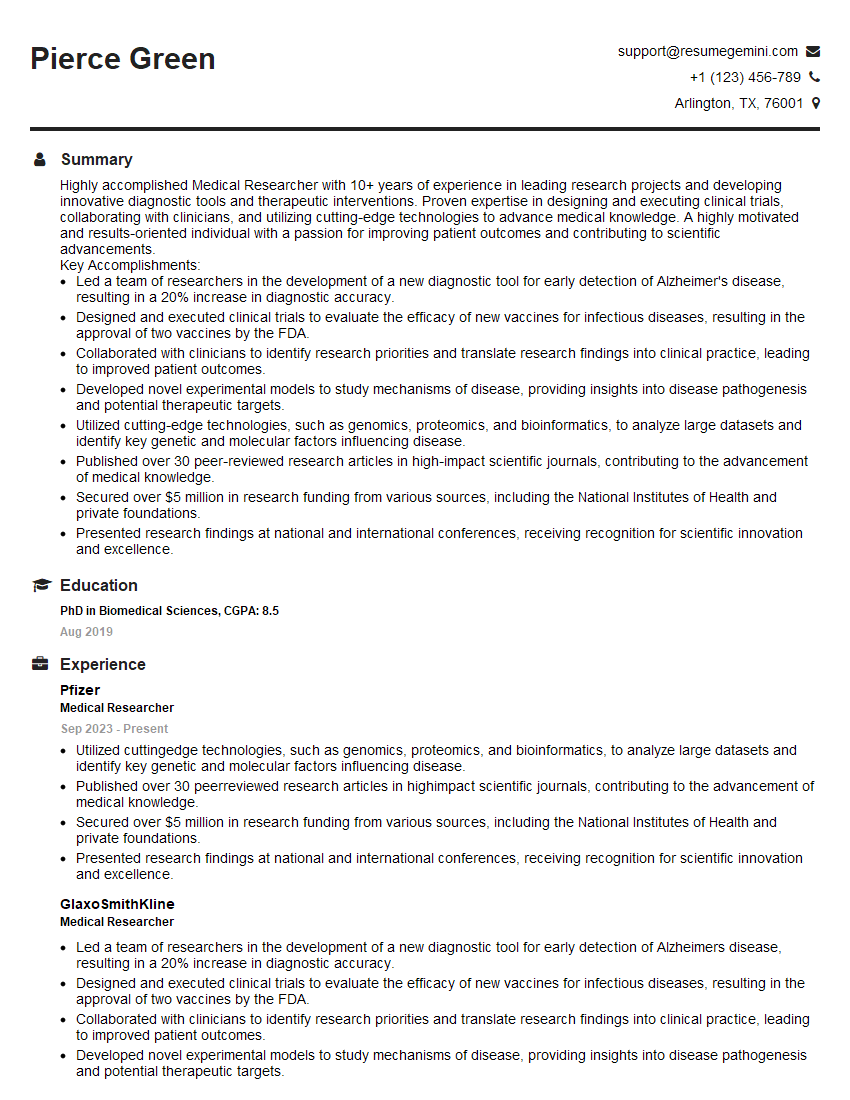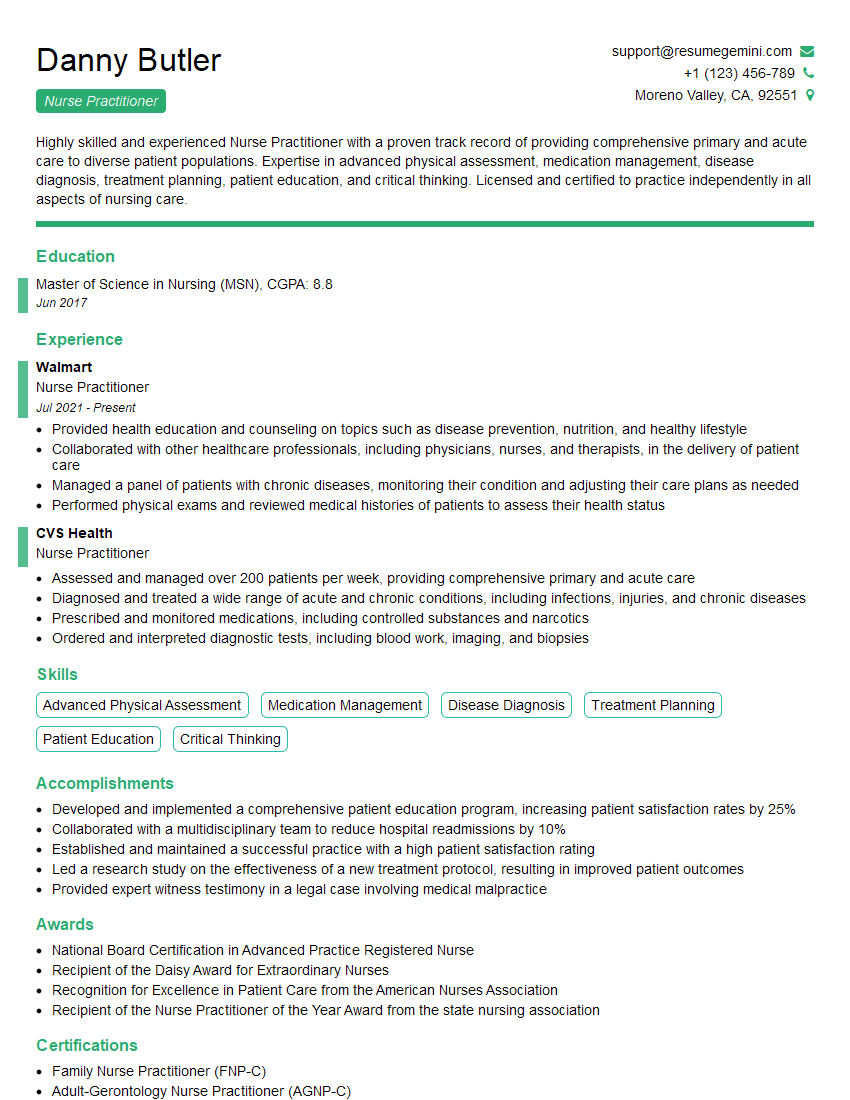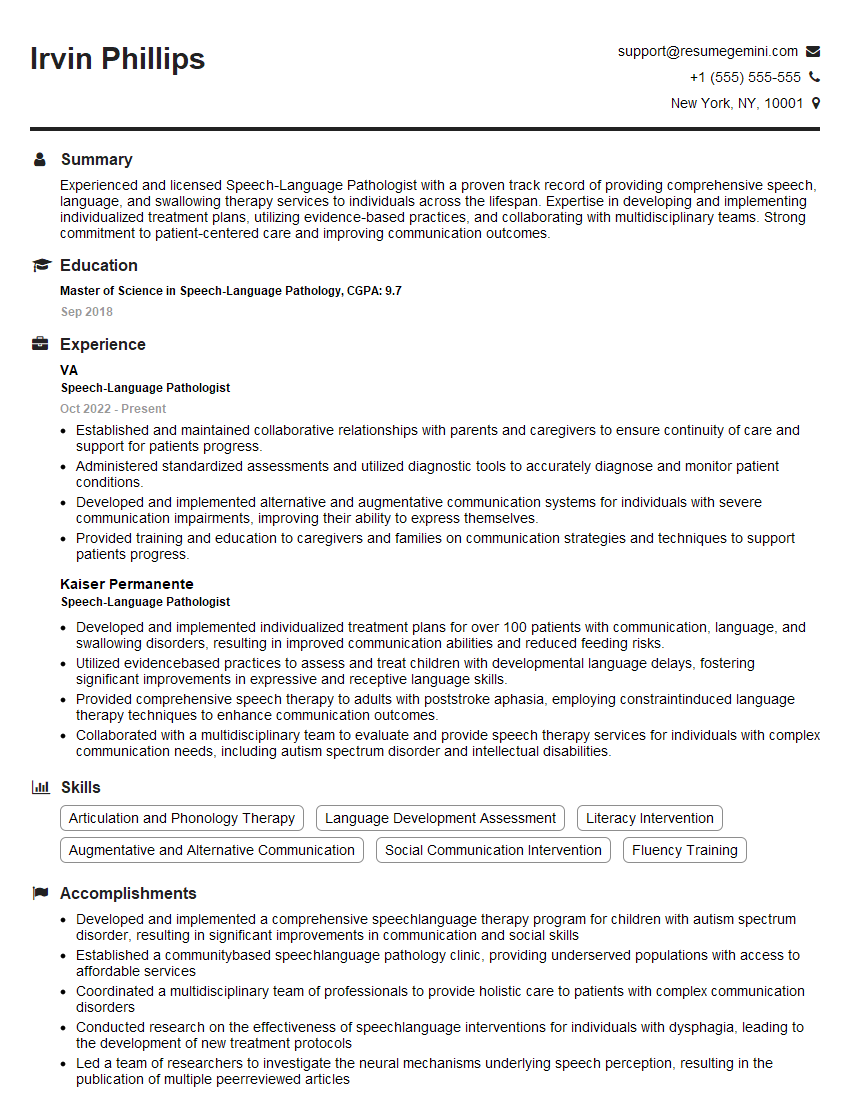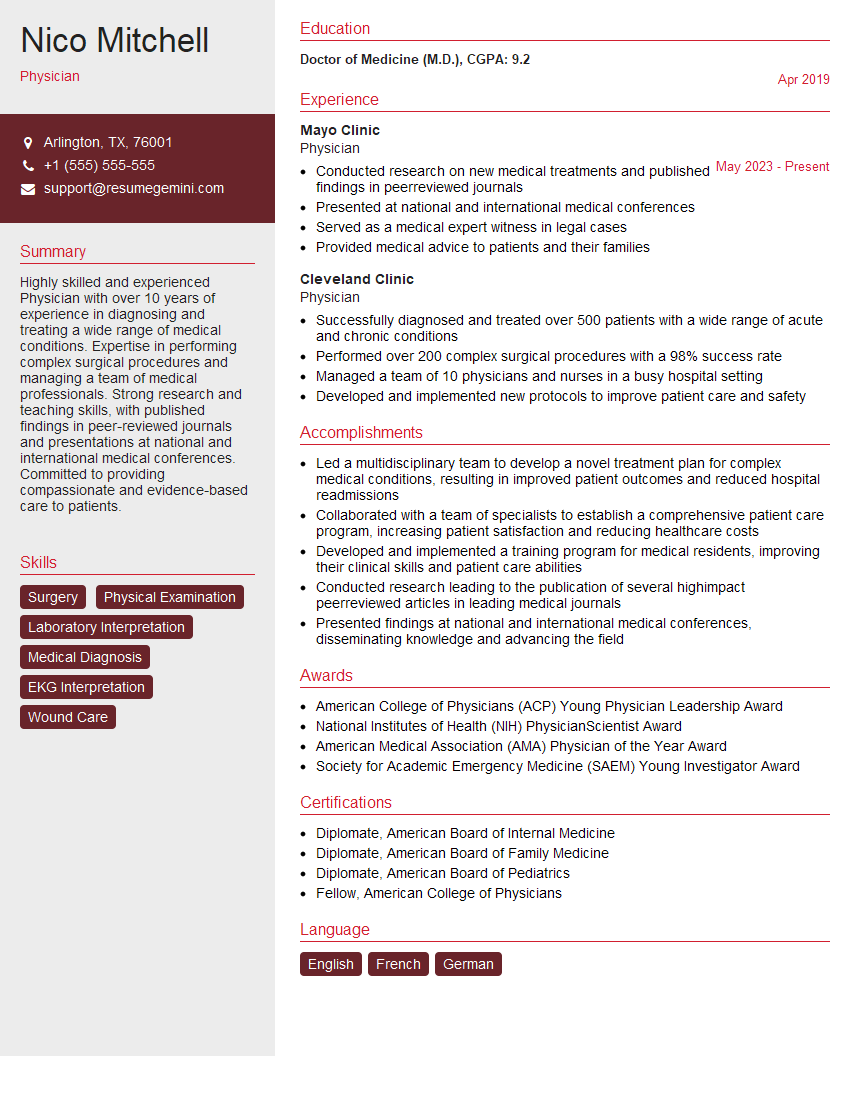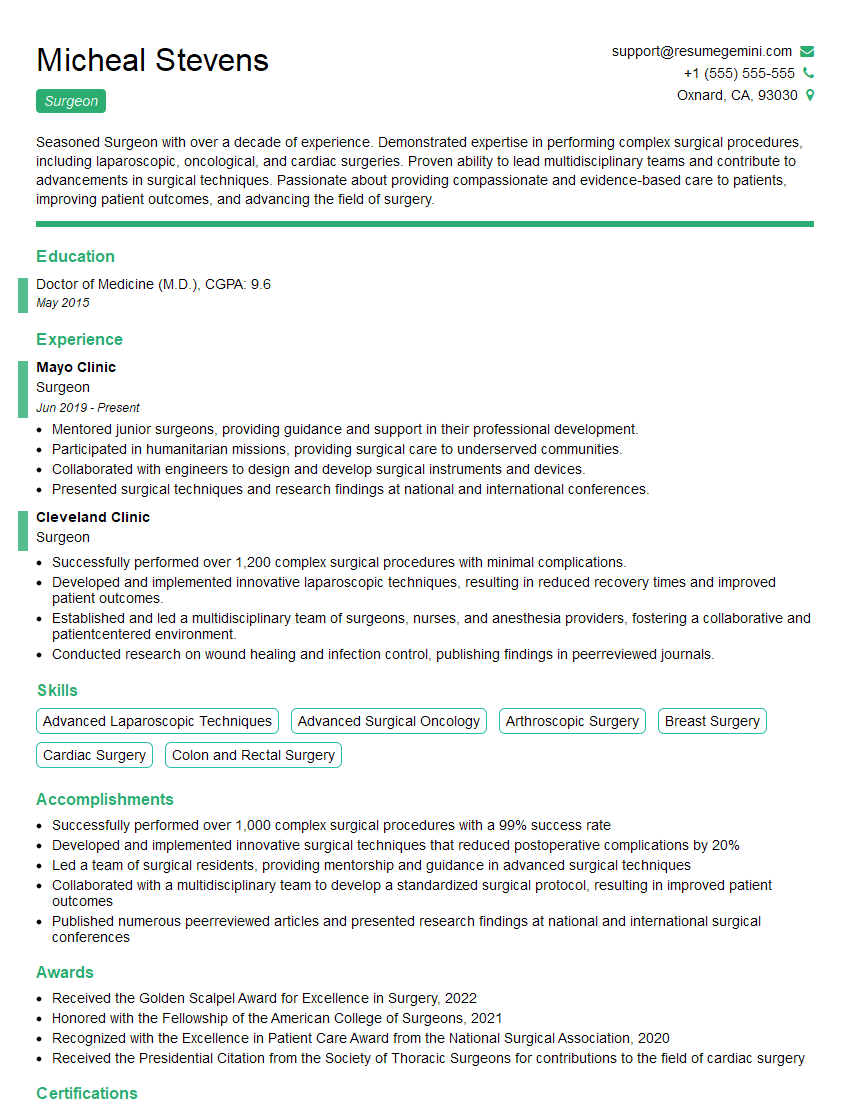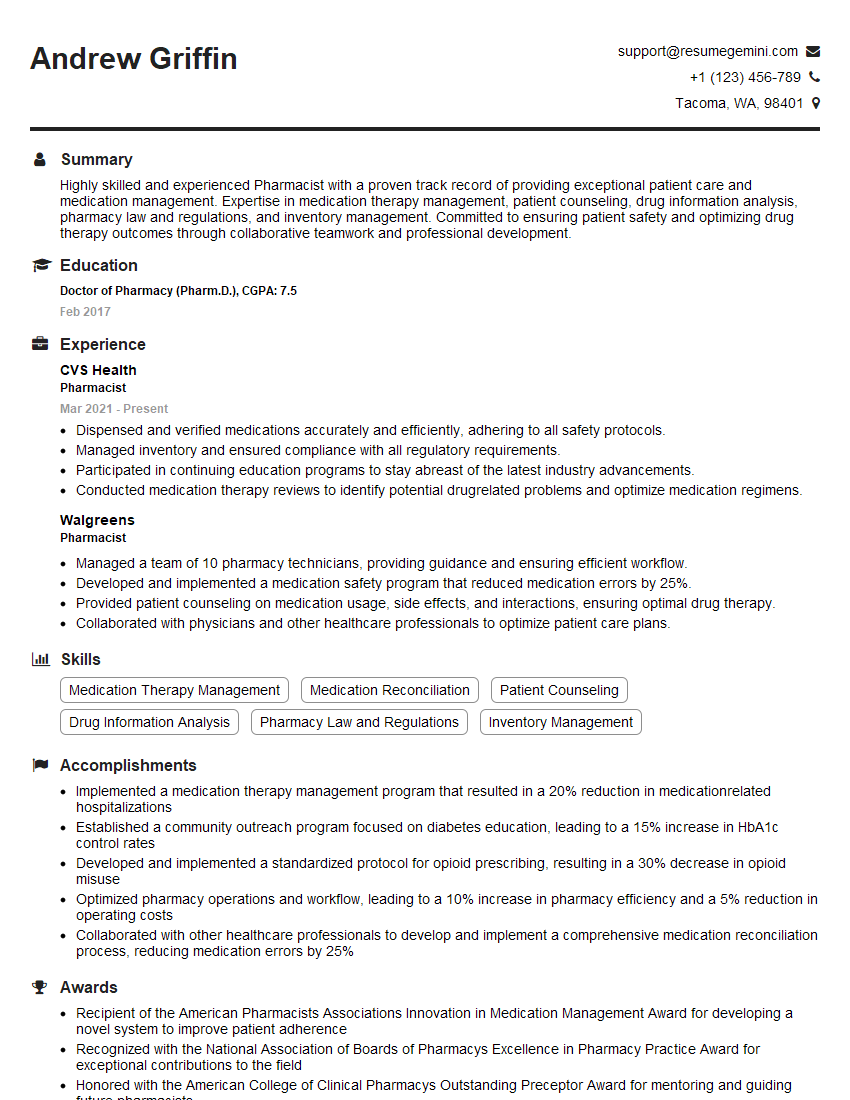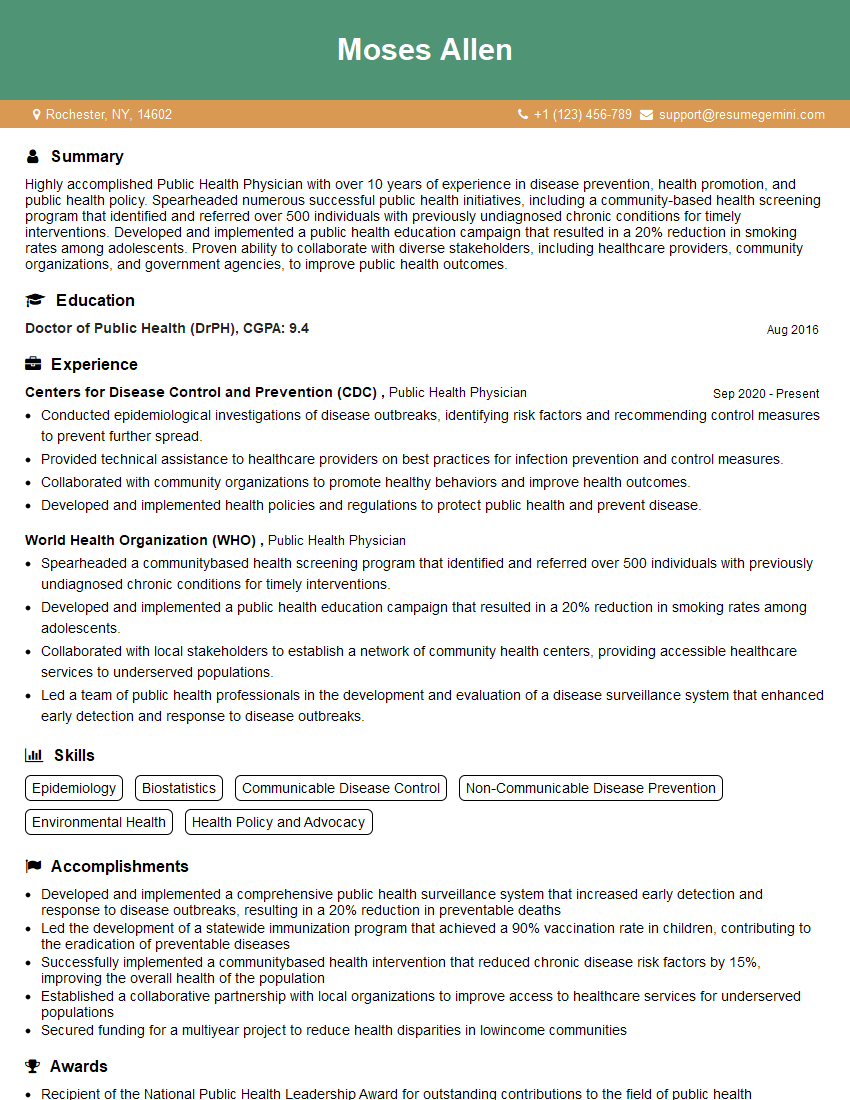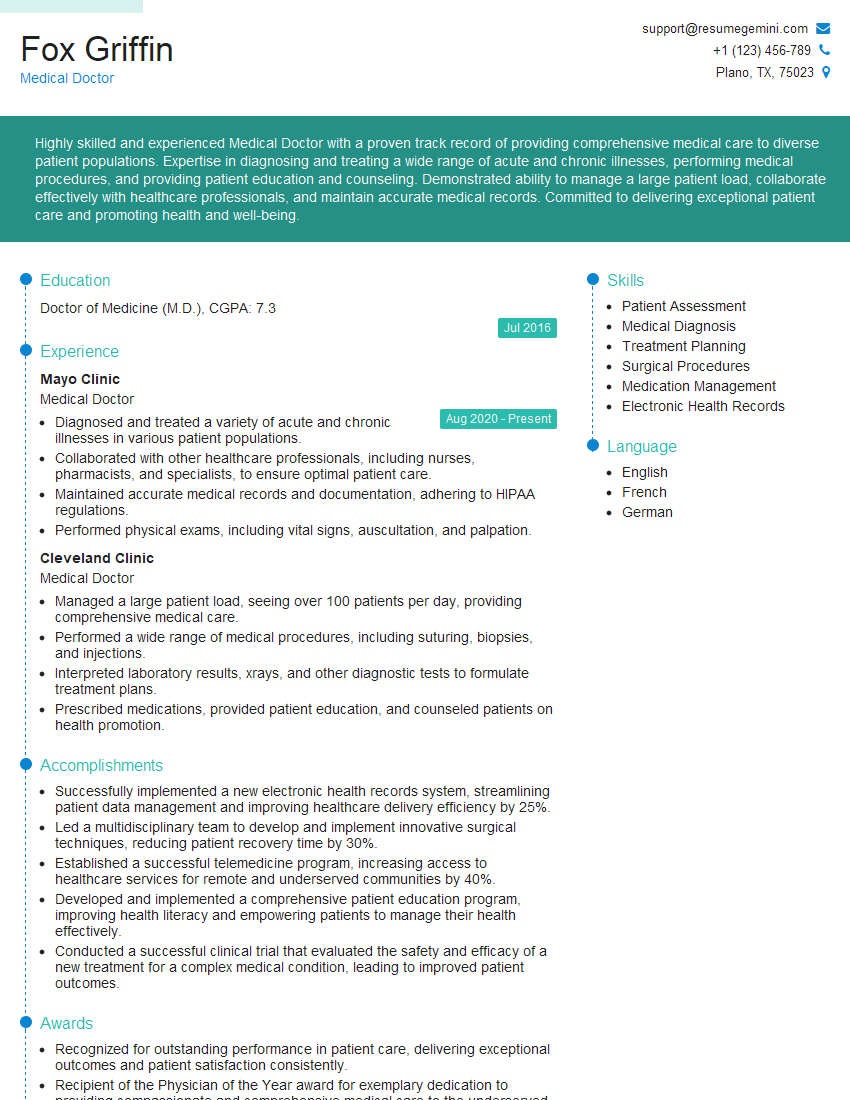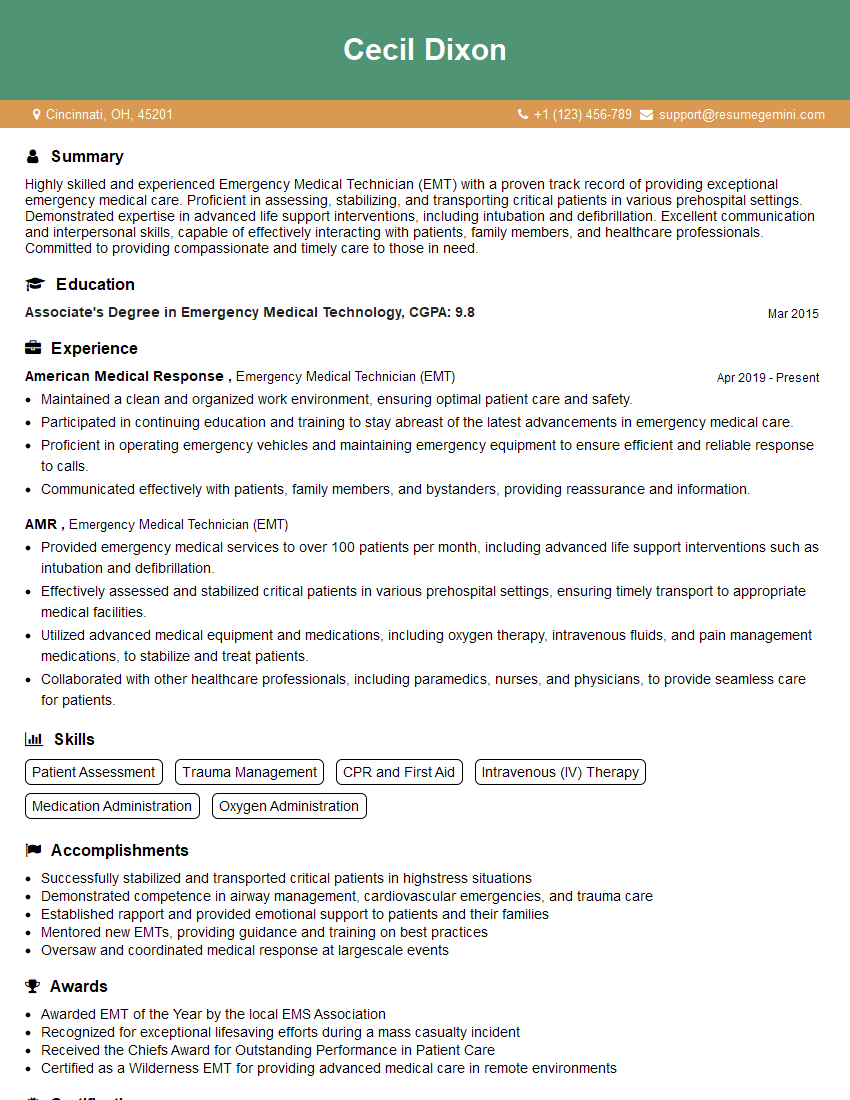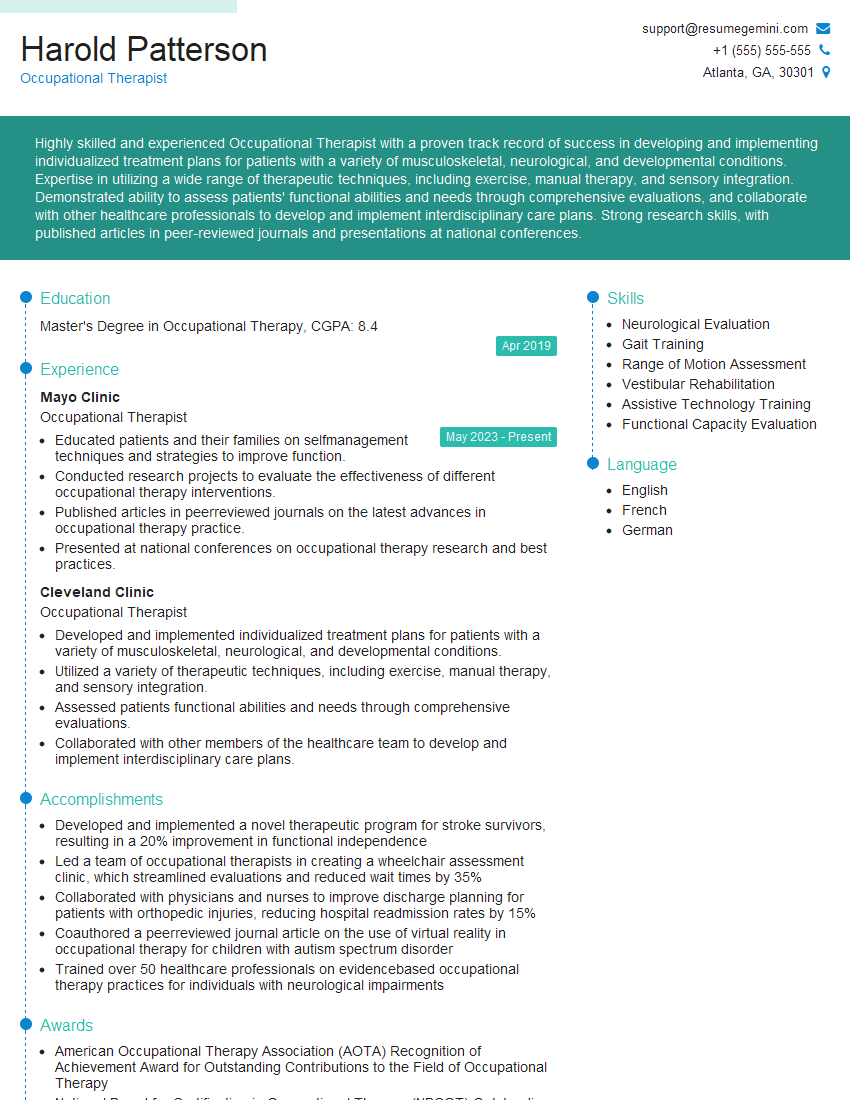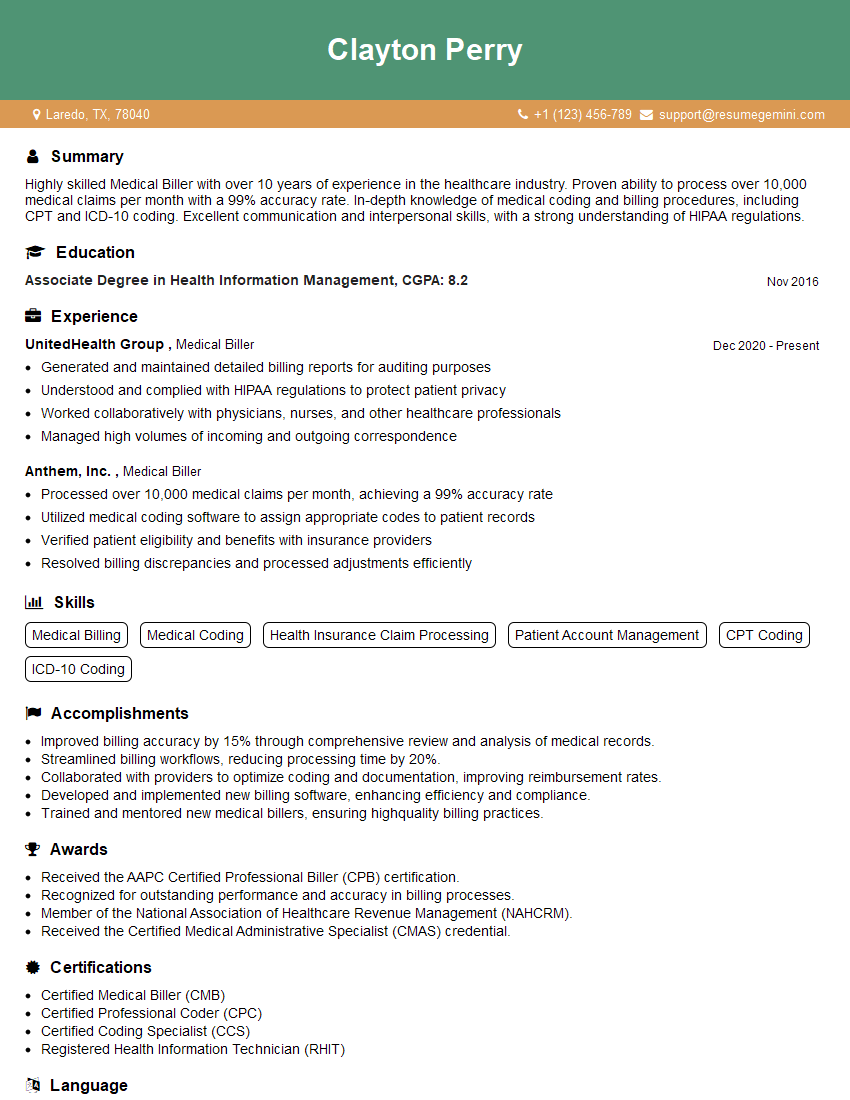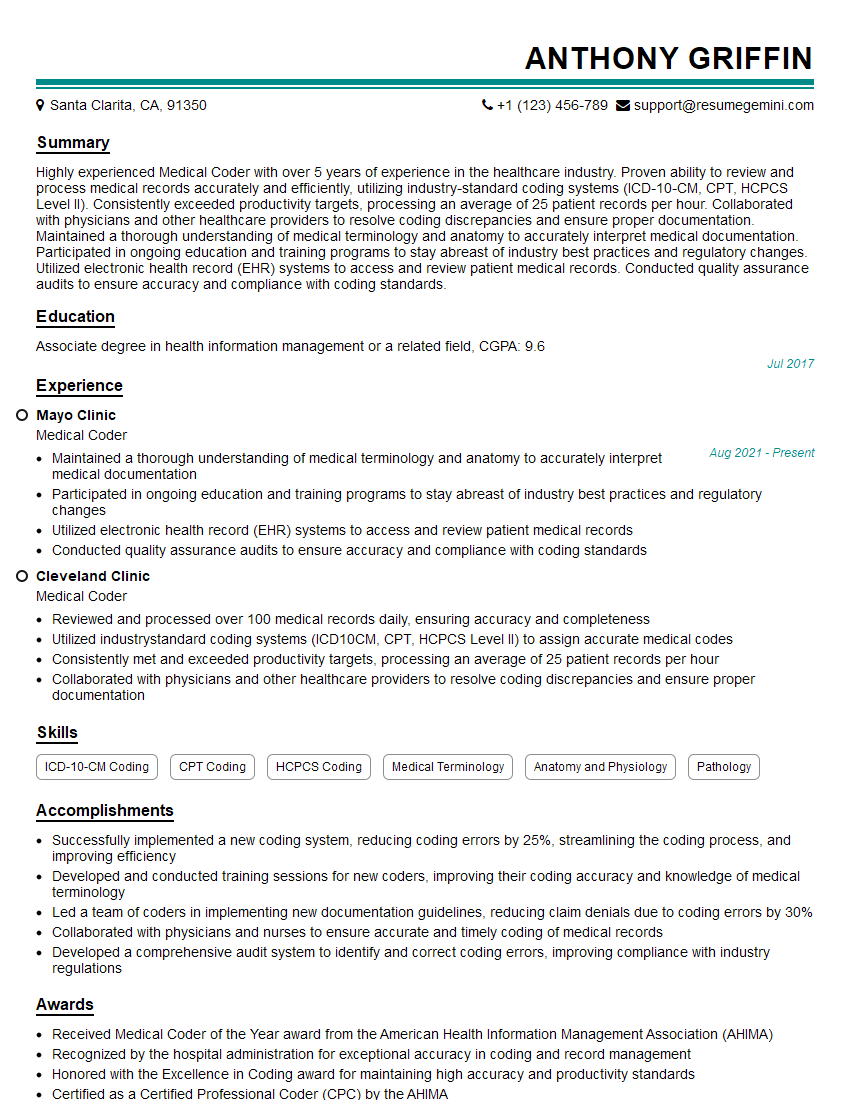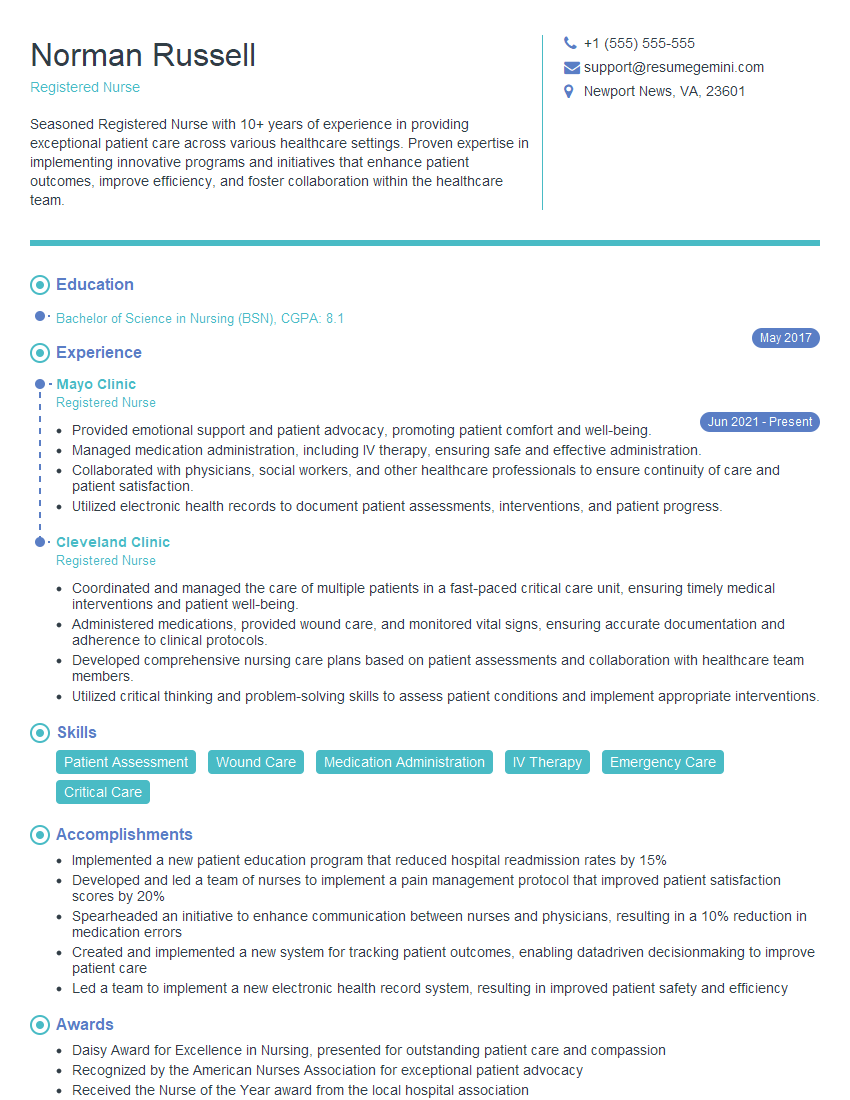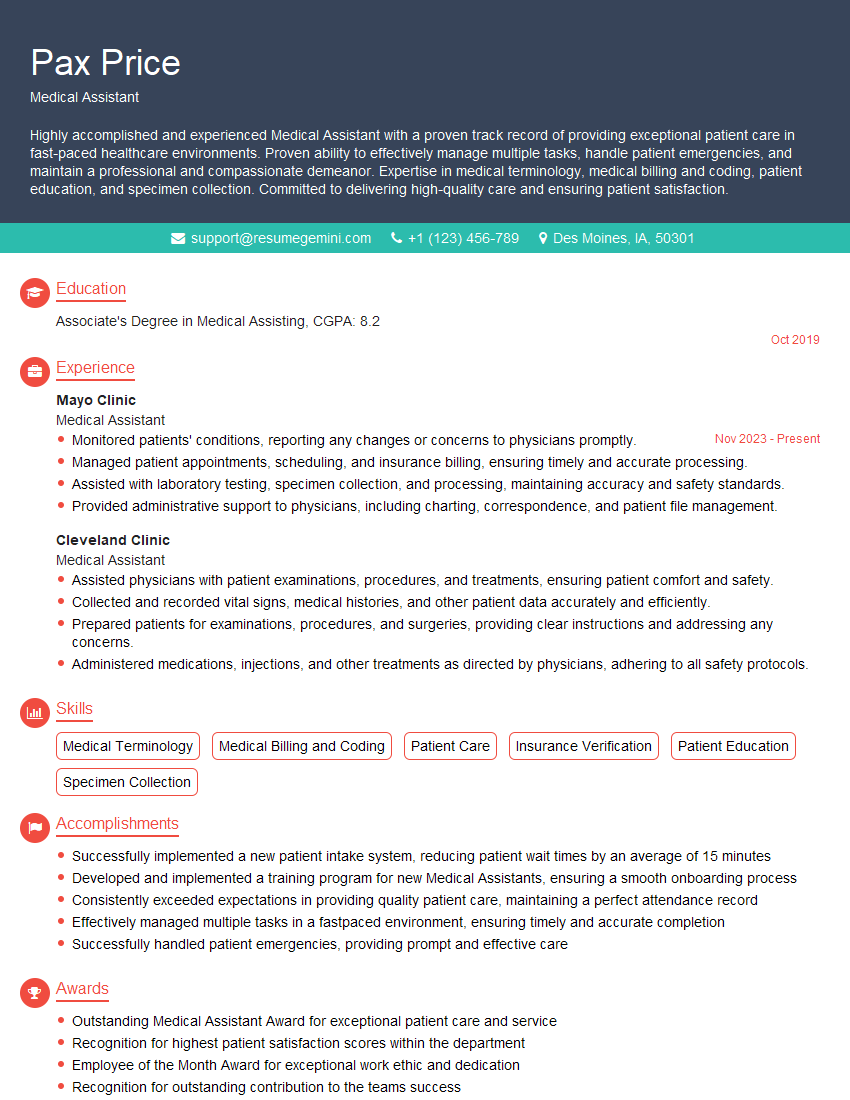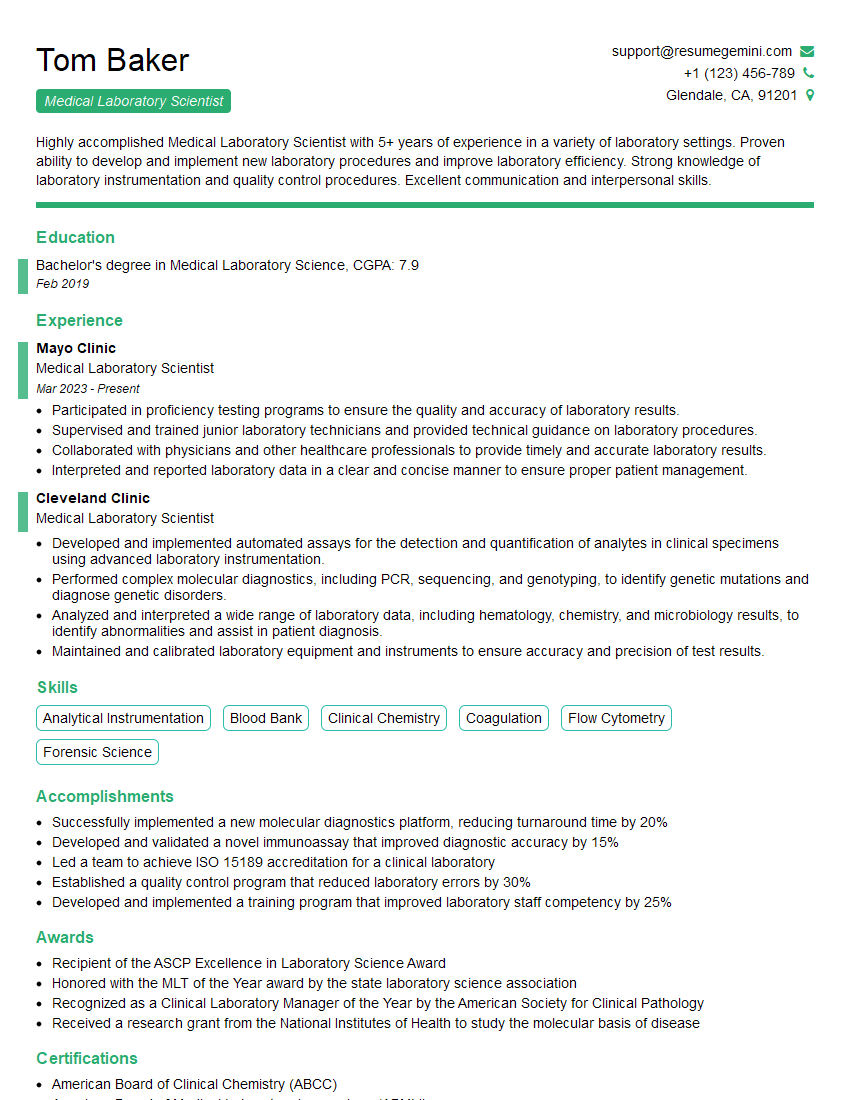Feeling uncertain about what to expect in your upcoming interview? We’ve got you covered! This blog highlights the most important Medicine and Healthcare interview questions and provides actionable advice to help you stand out as the ideal candidate. Let’s pave the way for your success.
Questions Asked in Medicine and Healthcare Interview
Q 1. Explain the difference between Type 1 and Type 2 diabetes.
Type 1 and Type 2 diabetes are both characterized by high blood sugar levels, but they differ significantly in their underlying causes and how the body handles insulin.
- Type 1 Diabetes: This is an autoimmune disease where the body’s immune system mistakenly attacks and destroys the insulin-producing beta cells in the pancreas. As a result, the body produces little to no insulin, a hormone crucial for transporting glucose from the bloodstream into cells for energy. Individuals with Type 1 diabetes require lifelong insulin therapy to survive. Think of it like a faulty insulin factory – the factory itself is damaged and can’t produce the product.
- Type 2 Diabetes: In Type 2 diabetes, the body either doesn’t produce enough insulin or the cells become resistant to the insulin’s effects, preventing glucose from entering cells effectively. This insulin resistance often develops gradually over time, frequently linked to lifestyle factors like obesity, inactivity, and poor diet. While some individuals with Type 2 diabetes may manage their condition with lifestyle changes and oral medications, many will eventually require insulin therapy. Imagine this as a factory that produces insulin, but the cells that need it have become unresponsive to it; or the factory is producing less than needed.
In short, Type 1 is an autoimmune condition resulting in insulin deficiency, while Type 2 is characterized by insulin resistance and/or insufficient insulin production, often stemming from lifestyle factors.
Q 2. Describe the process of administering intramuscular injections.
Administering an intramuscular (IM) injection requires careful technique to ensure the medication reaches the muscle tissue and minimizes discomfort and potential complications. The steps are as follows:
- Prepare the injection site: Clean the area with an antiseptic wipe using a circular motion from the center outwards.
- Choose the injection site: Common sites include the deltoid (upper arm), vastus lateralis (thigh), and ventrogluteal (buttock). Site selection depends on the patient’s age, muscle mass, and the medication’s volume.
- Prepare the syringe and needle: Draw the medication into the syringe, ensuring no air bubbles remain. Select the appropriate needle gauge and length based on the medication and patient’s muscle mass.
- Pinch the skin: Gently pinch the skin at the injection site to create a taut surface. This helps ensure the needle penetrates the muscle without hitting bone or other tissues.
- Insert the needle: Insert the needle at a 90-degree angle (or slightly less, depending on the site and patient’s muscle mass) with a swift, confident motion. Aspirate (pull back slightly on the plunger) before injecting to check for blood return. If you aspirate blood, remove the needle and choose a new site.
- Inject the medication: Slowly and steadily push the plunger to inject the medication.
- Remove the needle: Remove the needle at the same angle as insertion. Apply gentle pressure to the injection site with a clean gauze pad to prevent bleeding or bruising.
- Dispose of the needle and syringe properly: Use a puncture-resistant container designed for sharps disposal.
Example: When injecting into the deltoid, locate the acromion process (the bony point of the shoulder) and inject laterally and slightly inferior to it, avoiding the axillary nerve.
Q 3. What are the common signs and symptoms of a stroke?
Stroke, also known as a cerebrovascular accident (CVA), occurs when blood supply to a part of the brain is interrupted, causing damage to brain tissue. Recognizing the signs and symptoms quickly is crucial for timely treatment, which can significantly improve outcomes.
Common signs and symptoms can be remembered using the acronym FAST:
- Facial Drooping: One side of the face may droop or appear numb.
- Arm Weakness: Weakness or numbness in one arm may be present.
- Speech Difficulty: Slurred speech or difficulty understanding speech.
- Time: Time is crucial. Call emergency services immediately if you notice any of these symptoms.
Other symptoms may include:
- Sudden severe headache
- Sudden confusion or disorientation
- Loss of balance or coordination
- Vision problems, such as double vision or blurred vision
- Difficulty swallowing
It’s important to note that stroke symptoms can vary greatly depending on the area of the brain affected. Even if symptoms are mild or temporary, seeking immediate medical attention is critical.
Q 4. How would you handle a patient experiencing an allergic reaction?
Managing an allergic reaction requires a swift and systematic approach. The severity of the reaction dictates the response. Mild allergic reactions may only involve skin manifestations, while severe reactions, known as anaphylaxis, can be life-threatening.
- Assess the situation: Determine the severity of the reaction. Is it localized (skin rash, itching) or systemic (difficulty breathing, swelling)?
- Remove the allergen: If possible, identify and remove the source of the allergic reaction (e.g., insect sting, ingested food).
- Administer treatment: For mild reactions, antihistamines may be sufficient. For severe reactions (anaphylaxis), epinephrine (adrenaline) is the first-line treatment. Epinephrine is usually administered via auto-injector (like an EpiPen) into the thigh muscle. Call emergency medical services immediately.
- Monitor vital signs: Continuously monitor the patient’s breathing, heart rate, blood pressure, and oxygen saturation levels. Administer oxygen if necessary.
- Maintain airway patency: If the patient has difficulty breathing, be prepared to assist with airway management.
- Transport to the hospital: Even after administering epinephrine, transport the patient to a hospital for ongoing monitoring and treatment. Allergic reactions can recur.
Example: If a patient experiences anaphylaxis after a bee sting, remove the stinger if present, administer epinephrine immediately, call emergency medical services, and monitor vital signs until emergency personnel arrive.
Q 5. What is your experience with electronic health records (EHRs)?
Throughout my career, I’ve extensively utilized electronic health records (EHRs) in various settings, from large hospital systems to smaller clinics. My experience encompasses all aspects of EHR use, including:
- Data Entry: Accurately documenting patient encounters, including medical history, physical exam findings, diagnoses, treatment plans, and medication orders.
- Data Retrieval: Efficiently accessing patient information for clinical decision-making, facilitating continuity of care.
- Order Entry: Placing orders for laboratory tests, imaging studies, and medications, ensuring appropriate authorization and workflows.
- Communication: Utilizing EHR functionalities for secure messaging with colleagues and referring physicians.
- Reporting: Generating reports for quality improvement initiatives, administrative purposes, and research studies.
- Troubleshooting and Training: I’m proficient in troubleshooting technical issues and providing training to colleagues on EHR optimization.
I am familiar with several major EHR systems including Epic and Cerner. My experience allows me to effectively navigate and leverage EHR capabilities to enhance patient care and clinical efficiency.
Q 6. Describe your approach to patient communication and education.
Patient communication and education are integral to providing high-quality care. My approach centers on establishing a strong doctor-patient relationship built on trust, empathy, and shared decision-making. I strive to communicate clearly and concisely, using language appropriate to the patient’s understanding. I believe in actively listening to patients’ concerns, validating their feelings, and ensuring they feel heard and understood.
My approach includes:
- Active Listening: Paying close attention to verbal and nonverbal cues.
- Plain Language: Avoiding medical jargon and explaining complex information in simple terms.
- Shared Decision-Making: Involving patients in treatment plan development to enhance compliance and satisfaction.
- Visual Aids: Utilizing diagrams, charts, and other visual tools to enhance understanding.
- Written Materials: Providing patients with easy-to-understand instructions and educational resources.
- Follow-up: Ensuring patients have the resources and support they need after their appointments.
Example: When explaining a complex diagnosis, I use simple analogies, visuals, and actively encourage the patient to ask questions to ensure complete understanding. I also tailor my communication style to the patient’s individual needs and preferences.
Q 7. How do you prioritize patient care in a busy environment?
Prioritizing patient care in a busy environment requires a structured and efficient approach. My strategy involves:
- Triaging patients: Assessing patients’ needs and prioritizing those requiring immediate attention based on urgency and severity.
- Time Management: Optimizing workflow through efficient scheduling, delegation (where appropriate), and minimizing interruptions.
- Effective Delegation: Assigning tasks to qualified team members, ensuring proper follow-up and accountability.
- Prioritization Frameworks: Utilizing frameworks like ABC analysis or the Urgent/Important matrix to effectively manage competing demands.
- Teamwork: Collaborating with colleagues to ensure seamless patient flow and comprehensive care.
- Workflow Optimization: Identifying and eliminating bottlenecks in clinical processes.
Example: In an emergency room setting, I would prioritize patients with life-threatening conditions, such as cardiac arrest or severe respiratory distress, over those with less urgent needs. I’d coordinate with other team members to expedite care and ensure efficient use of resources.
Q 8. Explain your understanding of HIPAA regulations.
HIPAA, the Health Insurance Portability and Accountability Act of 1996, is a US federal law designed to protect sensitive patient health information. It establishes national standards for electronic healthcare transactions and protects the privacy and security of protected health information (PHI).
My understanding encompasses several key areas: Privacy Rule, which dictates how PHI can be used and disclosed; Security Rule, which outlines administrative, physical, and technical safeguards to protect electronic PHI; and Breach Notification Rule, which mandates reporting of unauthorized disclosures of PHI. I understand the implications of HIPAA violations, including hefty fines and potential criminal charges. For example, I know that even seemingly innocuous actions like discussing a patient’s case in a public area or failing to properly secure electronic medical records can constitute a HIPAA violation. My commitment is to strict adherence to all HIPAA regulations to ensure patient confidentiality and trust.
- Privacy Rule: Defines permissible uses and disclosures of PHI, including obtaining consent for treatment, payment, and healthcare operations (TPO).
- Security Rule: Requires implementing safeguards to protect electronic PHI from unauthorized access, use, disclosure, disruption, modification, or destruction.
- Breach Notification Rule: Outlines procedures for notifying individuals and government agencies in case of a data breach.
Q 9. Describe a time you had to make a difficult ethical decision in healthcare.
One particularly challenging ethical dilemma involved a patient with end-stage renal failure who refused dialysis. He understood the implications—it meant his life expectancy was significantly shortened—but he was adamant about maintaining his quality of life, even if it meant foregoing treatment. His family was distraught and pressured me to intervene, suggesting I override his wishes. However, I knew my ethical obligation was to respect his autonomy and his right to make informed decisions about his own body, even if those decisions seemed to be against his best interests medically. I engaged in extensive conversations with the patient, ensuring he fully understood the consequences, and provided him with resources to consider his options. Ultimately, I supported his decision, providing palliative care focused on comfort and dignity rather than aggressive treatment. This experience reinforced the importance of patient-centered care and prioritizing a patient’s autonomy, even when it means accepting a difficult outcome.
Q 10. What are the common side effects of this medication?
To answer this accurately, I need to know the specific medication. Side effects vary greatly depending on the drug in question. However, I can offer a general framework. Common side effects often listed in medication information include:
- Gastrointestinal: Nausea, vomiting, diarrhea, constipation
- Neurological: Headache, dizziness, drowsiness, insomnia
- Cardiovascular: Increased or decreased heart rate, changes in blood pressure
- Allergic Reactions: Rash, itching, swelling, difficulty breathing
- Other: Fatigue, weight changes
It’s crucial to always review the medication’s prescribing information (package insert) for a comprehensive list of potential side effects specific to that drug. Patients should also report any concerning side effects to their healthcare provider immediately.
Q 11. Explain the importance of hand hygiene in infection control.
Hand hygiene is paramount in infection control. It’s the single most effective method of preventing the spread of healthcare-associated infections (HAIs). HAIs are infections patients acquire during the course of receiving healthcare. Many are preventable through basic hygiene practices. Handwashing, or the use of alcohol-based hand rubs, removes transient microorganisms from the hands, reducing the risk of transmission to patients and healthcare workers.
The process involves thorough scrubbing with soap and water, or applying an alcohol-based rub, ensuring coverage of all surfaces of the hands and fingers. The effectiveness depends on several factors: the type of antimicrobial agent used, the duration of the washing/rubbing, and the thoroughness of the technique. Improper hand hygiene can lead to the spread of various pathogens, including bacteria, viruses, and fungi, causing infections such as pneumonia, urinary tract infections, and surgical site infections.
Q 12. How would you handle a disagreement with a colleague?
Disagreements among colleagues are inevitable in a healthcare setting. My approach focuses on professional and respectful communication. I’d begin by privately addressing the issue with my colleague, focusing on the specific point of contention rather than resorting to personal attacks. Active listening is key—understanding their perspective is as important as expressing my own. If a resolution isn’t reached, I’d involve a supervisor or another neutral colleague to mediate the discussion. The goal is to find a solution that benefits the patient and improves team dynamics. It’s important to remember that maintaining respectful professional relationships is crucial for patient safety and effective teamwork.
Q 13. Describe your experience with different medical imaging techniques (X-ray, CT, MRI).
My experience with medical imaging techniques includes extensive work with X-rays, CT scans, and MRIs. I understand their applications, limitations, and potential risks. X-rays are valuable for visualizing bones and detecting fractures; their low cost and relatively quick acquisition time makes them a cornerstone of diagnostic imaging. CT scans provide detailed cross-sectional images, useful for evaluating internal organs and soft tissues, and are especially beneficial in trauma situations. MRIs, on the other hand, provide exquisite soft-tissue contrast, making them superior for evaluating the brain, spinal cord, and other soft tissues; but they are more time-consuming and have contraindications for patients with certain metal implants.
I am familiar with interpreting images from these modalities and can incorporate this information into a comprehensive patient assessment. It’s crucial to select the most appropriate imaging technique based on the specific clinical question and patient factors.
Q 14. What is your experience with wound care?
My wound care experience encompasses a range of scenarios, from simple lacerations to complex chronic wounds such as pressure ulcers and diabetic foot ulcers. I’m proficient in assessing wound characteristics (size, depth, exudate, surrounding tissue), selecting appropriate dressings based on wound type and patient needs, and implementing preventative measures to minimize the risk of infection. I understand the importance of regular wound assessment, documentation, and patient education regarding wound care at home. I am also familiar with various wound healing modalities, including negative pressure wound therapy and advanced wound care products. My aim is to promote timely wound healing while minimizing pain and preventing complications.
Q 15. Explain your understanding of the different stages of grief and loss.
Understanding the stages of grief is crucial in providing compassionate patient care. While individual experiences vary greatly, the Kübler-Ross model offers a helpful framework, though it’s important to remember it’s not a rigid linear progression. The stages are:
- Denial: A temporary defense mechanism where the reality of the loss is avoided. For example, a patient recently diagnosed with a terminal illness might initially refuse to believe the prognosis.
- Anger: Frustration and resentment towards oneself, others, or even a higher power. This could manifest as irritability, outbursts, or blaming healthcare providers.
- Bargaining: Attempting to negotiate with a higher power or fate to change the outcome. A common example is promising to change one’s lifestyle if granted more time.
- Depression: Overwhelming sadness and despair, often accompanied by feelings of hopelessness and worthlessness. This can lead to withdrawal from social interactions.
- Acceptance: Coming to terms with the loss and finding a way to move forward. This doesn’t necessarily mean happiness, but rather a sense of peace and resolution.
It’s vital to remember that not everyone experiences all stages, and the order can vary significantly. Effective care involves validating the patient’s feelings, offering emotional support, and connecting them with resources such as grief counseling or support groups.
Career Expert Tips:
- Ace those interviews! Prepare effectively by reviewing the Top 50 Most Common Interview Questions on ResumeGemini.
- Navigate your job search with confidence! Explore a wide range of Career Tips on ResumeGemini. Learn about common challenges and recommendations to overcome them.
- Craft the perfect resume! Master the Art of Resume Writing with ResumeGemini’s guide. Showcase your unique qualifications and achievements effectively.
- Don’t miss out on holiday savings! Build your dream resume with ResumeGemini’s ATS optimized templates.
Q 16. How would you approach a patient who is non-compliant with their treatment plan?
Non-compliance is a significant challenge in healthcare. My approach would be multifaceted, focusing on building a strong therapeutic relationship and understanding the root causes of non-compliance. I’d start by having an open and empathetic conversation with the patient, actively listening to their concerns and perspectives. Some common reasons for non-compliance include:
- Side effects: Unmanageable side effects can make adherence difficult. We’d explore strategies to mitigate these, such as adjusting medication dosages or exploring alternative treatment options.
- Cost: The financial burden of medication or treatment can be prohibitive. I would help explore options like patient assistance programs or financial aid.
- Lack of understanding: If the patient doesn’t fully understand their condition or treatment plan, compliance is less likely. Clear, concise explanations, using visual aids if necessary, are essential.
- Lifestyle barriers: Complex medication regimens or lifestyle changes might be difficult to integrate into a busy life. We’d work collaboratively to develop a manageable plan.
Finally, I’d regularly monitor adherence and make adjustments as needed, always emphasizing shared decision-making and patient empowerment. This approach transforms the patient from a passive recipient of care into an active partner in their own healing.
Q 17. Explain the principles of sterile technique.
Sterile technique is crucial to prevent the introduction of microorganisms into a patient’s body during procedures, significantly reducing the risk of infection. The principles involve:
- Hand hygiene: Thorough handwashing with soap and water or using an alcohol-based hand rub is the cornerstone. It’s performed before and after every procedure.
- Environment: Maintaining a clean and disinfected work area. This might involve using disinfectants to clean surfaces before procedures.
- Barrier precautions: Using sterile gloves, gowns, masks, and drapes to create a physical barrier between the healthcare worker and the sterile field.
- Sterile field maintenance: Once a sterile field is established (e.g., opening a sterile package), it must be carefully maintained. Any contact with non-sterile objects contaminates the field.
- Aseptic technique: All actions are performed in a way that minimizes the risk of contamination. This involves careful handling of instruments and avoiding unnecessary touching of sterile surfaces.
For example, during a surgical procedure, the entire operating room environment is maintained under strict sterile conditions, with the surgical team following meticulous protocols to prevent infection. Any breach in sterile technique could have serious consequences for the patient, leading to potentially life-threatening infections.
Q 18. Describe your experience with managing chronic pain.
Managing chronic pain requires a holistic approach that combines pharmacological and non-pharmacological interventions tailored to the individual patient’s needs. My experience includes:
- Pharmacological management: Utilizing various analgesic medications, such as NSAIDs, opioids (with careful consideration of risks and benefits), and adjuvant medications to address specific symptoms.
- Non-pharmacological interventions: Employing therapies like physical therapy, occupational therapy, cognitive behavioral therapy (CBT), and relaxation techniques to help patients manage pain and improve their overall well-being.
- Multidisciplinary approach: Collaborating with other healthcare professionals, such as pain specialists, physical therapists, and psychologists, to develop a comprehensive treatment plan.
- Patient education and empowerment: Educating patients about their condition, treatment options, and self-management strategies, empowering them to actively participate in their care.
A successful example involved a patient with chronic back pain who responded poorly to opioids. We transitioned her to a multimodal approach incorporating physical therapy, CBT, and non-opioid analgesics, leading to significant pain reduction and improved quality of life. Each patient’s journey is unique, necessitating careful assessment and individualized treatment planning.
Q 19. How would you assess a patient’s pain level?
Assessing a patient’s pain level involves a multifaceted approach that goes beyond simply asking them a number on a scale. I use a combination of methods:
- Pain scales: Using standardized pain scales, such as the 0-10 numerical rating scale or the visual analog scale (VAS), provides a quantifiable measure of pain intensity.
- Qualitative assessment: Exploring the patient’s description of their pain, including location, quality (e.g., sharp, burning, aching), intensity, duration, and aggravating/relieving factors. This provides valuable context.
- Observation: Observing the patient’s nonverbal cues, such as facial expressions, posture, and body language, can offer additional insights into their pain experience.
- Impact assessment: Understanding how the pain affects the patient’s daily life, including their sleep, activity levels, mood, and overall functioning. This contextualizes the pain’s severity.
For instance, a patient might rate their pain as a 7/10 on a numerical scale but describe it as a constant, dull ache that prevents them from sleeping. This combination of quantitative and qualitative information provides a holistic understanding of their pain and guides treatment decisions.
Q 20. What is your experience with palliative care?
My experience with palliative care focuses on providing comfort and improving the quality of life for patients with serious illnesses. This involves a holistic approach addressing physical, emotional, social, and spiritual needs. My work includes:
- Symptom management: Addressing pain, nausea, shortness of breath, and other distressing symptoms using a combination of medications and supportive care.
- Emotional and spiritual support: Providing emotional support to patients and their families, facilitating communication, and connecting them with spiritual resources if desired.
- Advance care planning: Assisting patients and families in making informed decisions about end-of-life care, including advance directives and goals of care.
- Coordination of care: Working with a multidisciplinary team to coordinate care and ensure the patient receives the best possible support.
A particularly memorable case involved a patient with advanced cancer who was experiencing significant pain and anxiety. Through a combination of medication adjustments, supportive counseling, and family involvement, we were able to significantly improve her comfort and quality of life during her final weeks, allowing her to spend meaningful time with her loved ones.
Q 21. What are the risk factors for developing heart disease?
Heart disease, encompassing conditions affecting the heart’s structure and function, is influenced by several risk factors. These can be categorized as:
- Modifiable risk factors: These are factors that can be changed through lifestyle modifications or medical interventions.
- High blood pressure (hypertension): Damages blood vessels and increases the heart’s workload.
- High cholesterol: Contributes to plaque buildup in arteries (atherosclerosis).
- Smoking: Damages blood vessels and increases the risk of blood clots.
- Diabetes: Damages blood vessels and increases the risk of heart disease complications.
- Obesity: Increases the risk of hypertension, high cholesterol, and diabetes.
- Physical inactivity: Contributes to weight gain, high blood pressure, and high cholesterol.
- Unhealthy diet: High consumption of saturated and trans fats increases cholesterol levels.
- Excessive alcohol consumption: Increases blood pressure and can damage the heart muscle.
- Non-modifiable risk factors: These are factors that cannot be changed, but their impact can sometimes be mitigated.
- Age: Risk increases with age.
- Family history: Having a family history of heart disease increases the risk.
- Gender: Men are generally at higher risk than women, although this gap narrows after menopause.
Understanding and managing these risk factors is crucial in preventing or delaying the onset of heart disease. Lifestyle changes, such as adopting a healthy diet, engaging in regular physical activity, and quitting smoking, can significantly reduce the risk.
Q 22. Explain your understanding of the different types of cancer.
Cancer is a broad term encompassing a large group of diseases characterized by the uncontrolled growth and spread of abnormal cells. These cells can originate in any part of the body and can invade and destroy nearby tissues. There are many different types of cancer, classified primarily by the type of cell they originate from and their location in the body.
- Carcinomas: These are cancers that begin in the skin or tissues that line or cover internal organs. They are the most common type, including lung cancer, breast cancer, and colon cancer.
- Sarcomas: These cancers originate in the bone, cartilage, fat, muscle, blood vessels, or other connective or supportive tissue. Examples include osteosarcoma (bone cancer) and liposarcoma (fat cancer).
- Leukemias: These cancers affect the blood-forming tissues, such as the bone marrow and the lymphatic system. They result in an abnormal increase of white blood cells.
- Lymphomas: These cancers begin in the cells of the immune system, called lymphocytes. Hodgkin’s lymphoma and non-Hodgkin’s lymphoma are two main types.
- Myelomas: This type of cancer affects plasma cells, a type of white blood cell in the bone marrow.
The classification is crucial for determining the appropriate treatment strategy. For instance, a lung carcinoma requires a different approach than a leukemia. The staging of the cancer, indicating its extent, further refines treatment planning.
Q 23. How would you interpret these lab results?
To interpret lab results accurately, I need the specific lab results. However, I can outline the general approach. I would first look at the complete blood count (CBC) for any abnormalities in white blood cell count (infection, leukemia), red blood cell count (anemia), or platelet count (bleeding disorders). Next, I would examine liver and kidney function tests (LFTs and KFTs) to assess organ health. Tumor markers, such as PSA (prostate-specific antigen) or CA-125 (ovarian cancer), would be analyzed in the context of clinical suspicion. Finally, I would consider imaging results (X-rays, CT scans, MRIs) which provide anatomical information and confirm the findings of blood tests. Interpreting lab results requires a holistic approach, considering the patient’s medical history, physical examination findings, and other diagnostic tests.
For example, elevated liver enzymes (ALT, AST) might suggest liver damage, which could be caused by various factors, including viral hepatitis or medication side effects. A complete picture needs to be built before any conclusions are drawn. I would never interpret results in isolation; patient context is paramount.
Q 24. What is your experience with patient advocacy?
Patient advocacy is a cornerstone of my practice. I believe in empowering patients to understand their diagnosis, treatment options, and prognosis. This involves actively listening to their concerns, explaining medical information in clear and accessible terms, and respecting their autonomy in making decisions about their care. I’ve been involved in numerous instances where I’ve helped patients navigate the complexities of the healthcare system, advocating for access to specialized care, financial assistance, and emotional support. For example, I recently assisted a patient in obtaining approval for a costly medication through their insurance company, ensuring they received the treatment they needed without facing undue financial burden.
My approach is collaborative. I see myself as a partner with my patients, working alongside them to achieve the best possible outcomes. Effective communication and building trust are key to successful patient advocacy.
Q 25. Describe your knowledge of infection prevention and control measures.
Infection prevention and control are critical to patient safety and the overall health of a healthcare setting. My knowledge encompasses a wide range of measures, including hand hygiene (the most crucial), appropriate use of personal protective equipment (PPE), such as gloves, gowns, masks, and eye protection, sterilization and disinfection of medical equipment, and adherence to isolation protocols. I’m familiar with different levels of isolation precautions – standard, contact, droplet, and airborne – and understand the specific procedures for each. Additionally, I’m aware of surveillance methods to track infections within a healthcare facility and implement strategies to contain outbreaks. For example, regular audits are conducted for compliance with hand hygiene protocols, and prompt responses are initiated in case of suspected outbreaks.
I understand the importance of educating both healthcare professionals and patients on infection control practices. Effective communication prevents the spread of infections and protects vulnerable individuals.
Q 26. Explain the different types of surgical procedures you’re familiar with.
My experience encompasses a broad range of surgical procedures. I’m familiar with minimally invasive techniques like laparoscopy and endoscopy, which often result in smaller incisions, less pain, and faster recovery times. I also have experience with open surgical procedures when minimally invasive approaches aren’t feasible. Specific examples include procedures in general surgery (e.g., appendectomy, cholecystectomy), cardiovascular surgery (e.g., coronary artery bypass grafting), orthopedic surgery (e.g., joint replacements), and neurosurgery (e.g., craniotomy). My knowledge extends to both elective and emergency procedures. The choice of procedure is determined by several factors including the patient’s overall health, the nature of the condition, and the availability of resources.
It’s crucial to remember that successful surgery requires careful pre-operative planning, skilled execution, and diligent post-operative care. All aspects are integral to patient safety and a positive outcome.
Q 27. How do you stay updated on the latest medical advancements?
Staying updated in medicine requires a multifaceted approach. I regularly read peer-reviewed medical journals, such as The Lancet, The New England Journal of Medicine, and JAMA, to keep abreast of the latest research findings. I attend national and international medical conferences and workshops to learn from leading experts in the field. Moreover, I actively participate in continuing medical education (CME) programs to earn credits and maintain my medical license. These programs are designed to keep medical professionals up to date on advancements in diagnosis, treatment, and technology. I also utilize online medical resources and databases, such as PubMed, to access and evaluate research articles. Professional memberships in medical organizations further enhance my access to information and collaborative learning opportunities.
Lifelong learning is essential in medicine; the field is constantly evolving, and staying updated ensures the best patient care.
Key Topics to Learn for Medicine and Healthcare Interviews
- Patient Care & Communication: Understanding patient-centered care models, effective communication techniques (verbal and non-verbal), and strategies for managing challenging patient interactions. Consider the ethical dimensions of patient care and informed consent.
- Medical Ethics & Law: Familiarize yourself with key ethical principles (autonomy, beneficence, non-maleficence, justice), relevant legal frameworks (e.g., HIPAA), and common ethical dilemmas faced in healthcare settings. Practice analyzing case studies involving ethical conflicts.
- Healthcare Systems & Policy: Gain a solid understanding of different healthcare delivery models (e.g., HMOs, PPOs), healthcare financing mechanisms, and current healthcare policy debates. Analyze the impact of policy changes on healthcare access and quality.
- Teamwork & Collaboration: Understand the importance of interprofessional collaboration, effective teamwork dynamics, and conflict resolution strategies within a healthcare team. Reflect on experiences demonstrating collaborative skills.
- Technological Advancements in Healthcare: Explore the impact of technology on patient care, diagnostics, and treatment. This could include Electronic Health Records (EHRs), telehealth, and medical imaging techniques.
- Quality Improvement & Patient Safety: Familiarize yourself with quality improvement methodologies (e.g., Lean, Six Sigma) and strategies for enhancing patient safety. Understand the role of risk management in healthcare.
- Data Analysis & Interpretation: Develop your ability to interpret and analyze medical data, including vital signs, lab results, and medical imaging. Practice drawing inferences from data and explaining your reasoning.
Next Steps
Mastering these key areas in Medicine and Healthcare will significantly enhance your career prospects, opening doors to rewarding and impactful roles. A strong resume is crucial for showcasing your skills and experience to potential employers. Building an ATS-friendly resume is essential to ensuring your application gets noticed. We recommend using ResumeGemini, a trusted resource, to craft a professional and effective resume that highlights your qualifications. ResumeGemini provides examples of resumes tailored specifically to the Medicine and Healthcare fields, helping you create a document that truly stands out.
Explore more articles
Users Rating of Our Blogs
Share Your Experience
We value your feedback! Please rate our content and share your thoughts (optional).
What Readers Say About Our Blog
Interesting Article, I liked the depth of knowledge you’ve shared.
Helpful, thanks for sharing.
Hi, I represent a social media marketing agency and liked your blog
Hi, I represent an SEO company that specialises in getting you AI citations and higher rankings on Google. I’d like to offer you a 100% free SEO audit for your website. Would you be interested?
